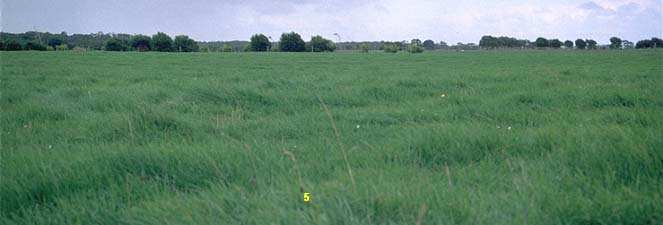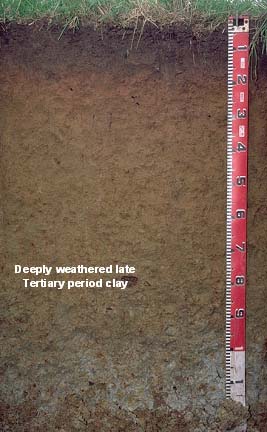Site SW5
| Location: Ayrford. | Australian Soil Classification: Mottled-Sodic, Eutrophic, Brown DERMOSOL/ ferric kaolinitic clay. |
| Northcote Factual Key: Gn 3.71 | Great Soil Group: brown podzolic. |
| General Landscape Description: Level plain. | Geology: Tertiary deposits: Hanson Plain Sand (Tpb). Lateritization evident. |
 Site SW5 landscape |
Soil Profile Morphology:
Surface Soil
| A1 | 0-15 cm | Brown (10YR4/3); very fine sandy clay loam; weak to moderate medium blocky structure; weak consistence moist; contains few (2- 5%) ferromanganiferous nodules (2-4 mm size); pH 5.9; abrupt change to: |  Site SW5 profile photo. |
| Subsoil | |||
| B21 | 15-25 cm | Yellowish red (5YR5/6); light clay (subplastic); moderate medium blocky structure; weak consistence moist; contains few (2-5%) ferromanganiferous nodules (2 -10 mm size); pH 6.0; clear change to: | |
| B22 | 25-50 cm | Yellowish brown (10YR5/6) with strong brown (7.5YR5/6) mottles; light clay (subplastic); moderate medium blocky structure; weak consistence, moderately moist; contains a few (5%) ferromanganiferous concretions (2-10 mm size); pH 6.0; clear change to: | |
| B23 | 50-75 cm | Yellowish brown (10YR5/6) with strong brown (7.5YR5/6) mottles; light medium clay (subplastic); strong coarse polyhedral, parting to fine polyhedral structure; pH 6.8: | |
| B24 | 75-95cm | Yellowish brown (10YR5/6); light clay (subplastic); strong medium-coarse polyhedral, breaking to strong fine polyhedral structure; very firm consistence, moderately moist; ferruginous concretions (2 - 8 cm size) common (20%); pH 5.9: | |
| B3 | 95 cm+ | Light grey (2.5Y7/0) with brownish yellow (10YR6/6) mottles; light clay (subplastic); strong consistence dry; contains many (50%) ferruginous concretions (2-10 cm size); pH 5.6. | |
Key Profile Features:
- Lack of strong texture contrast between surface (A) horizon and subsoil (B21) horizon.
- Deeply weathered late Tertiary clay horizon in deep subsoil.
 |  |
|
|
 |  |
|
Horizon | Horizon Depth (cm) | pH (water) | pH CaCl2 | EC 1:5 | NaCl % | Exchangeable Cations | |||
Ca | Mg | K | Na | ||||||
meq/100g | |||||||||
A1 | 0-15 | 5.9 | 5.4 | 0.19 | 9.4 | 1.7 | 0.64 | 0.70 | |
B21 | 15-25 | 6.0 | 5.7 | 0.22 | 5.4 | 1.3 | 0.33 | 0.47 | |
B22 | 25-30 | 6 | 5.8 | 0.17 | 4.1 | 3.4 | 0.21 | 0.65 | |
B23 | 50-75 | 6.8 | 6.3 | 0.16 | 3.1 | 6.0 | 0.20 | 0.87 | |
B24 | 75-95 | 5.9 | 5.4 | 0.61 | <0.05 | 3.5 | 5.2 | 0.15 | 0.84 |
B3 | 95+ | 5.6 | 4.9 | 0.32 | <0.05 | 4.3 | 4.1 | 0.14 | 0.94 |
Horizon | Horizon Depth (cm) | Wilting Point pF4.2 | Coarse Sand (0.2-2.0 mm) | Fine Sand (0.02-0.2 mm) | Silt (0.002-0.02 mm) | Clay (<0.002 mm) |
A1 | 0-15 | 19 | 9 | 37 | 12 | 29 |
B21 | 15-25 | 17 | 8 | 36 | 13 | 41 |
B22 | 25-30 | 19 | 8 | 31 | 9 | 52 |
B23 | 50-75 | 28 | 5 | 17 | 6 | 74 |
B24 | 75-95 | 26 | 9 | 17 | 5 | 72 |
B3 | 95+ | 23 | 17 | 19 | 4 | 62 |
Management Considerations:
Whole Profile
- Plant available water capacity (PAWC) is considered to be moderate (estimated at 120 mm) for the top metre of the soil profile. This is based on available laboratory data.
- The surface soil has a high organic matter content. Organic matter is important in terms of promoting aggregation of soils such as these with high fine sand and silt contents.
- The nutrient status of the surface soil is moderate (based on the sum of the exchangeable basic cations).
- The subplastic properties of the subsoil may lead to problems with sealing of earth dams. Sealing can be improved by compaction at the optimum water content and treatment with sodium tri-polyphosphate or addition of bentonite (Rolfe 1989).


